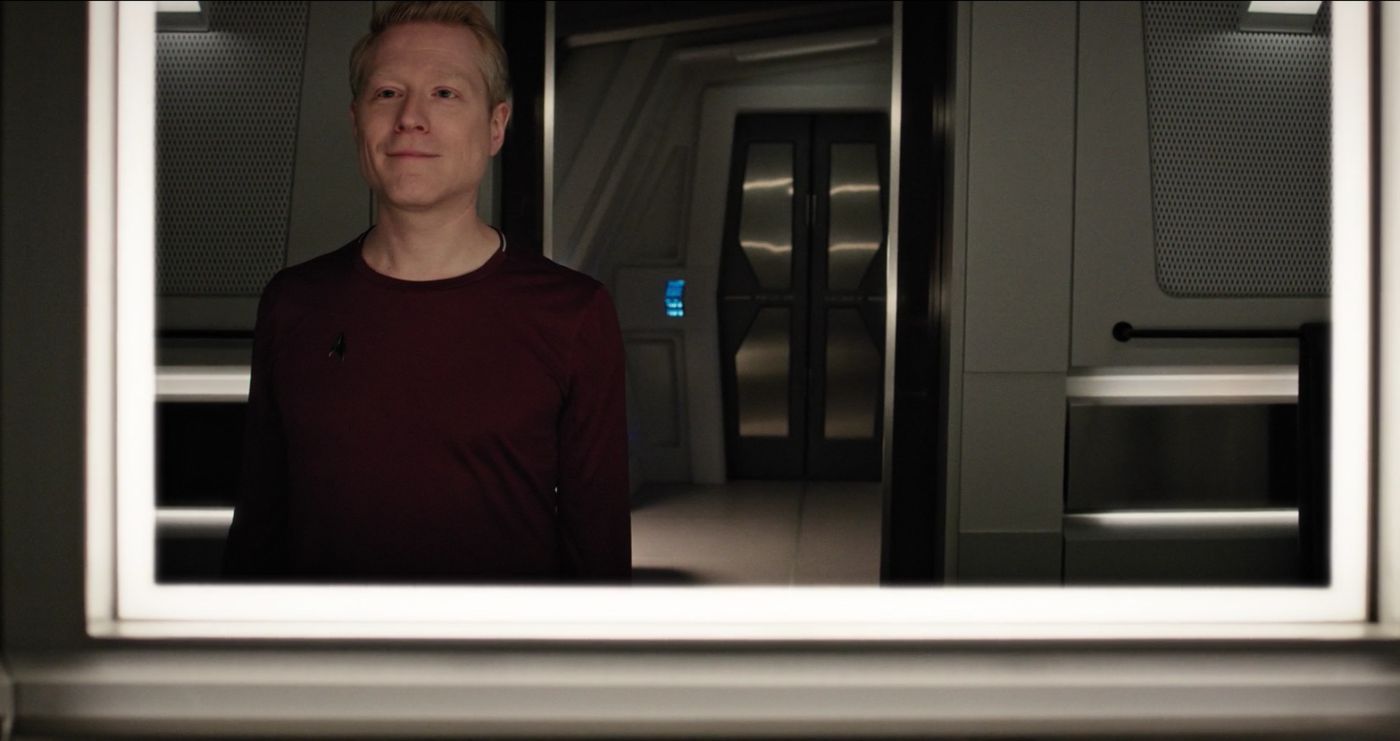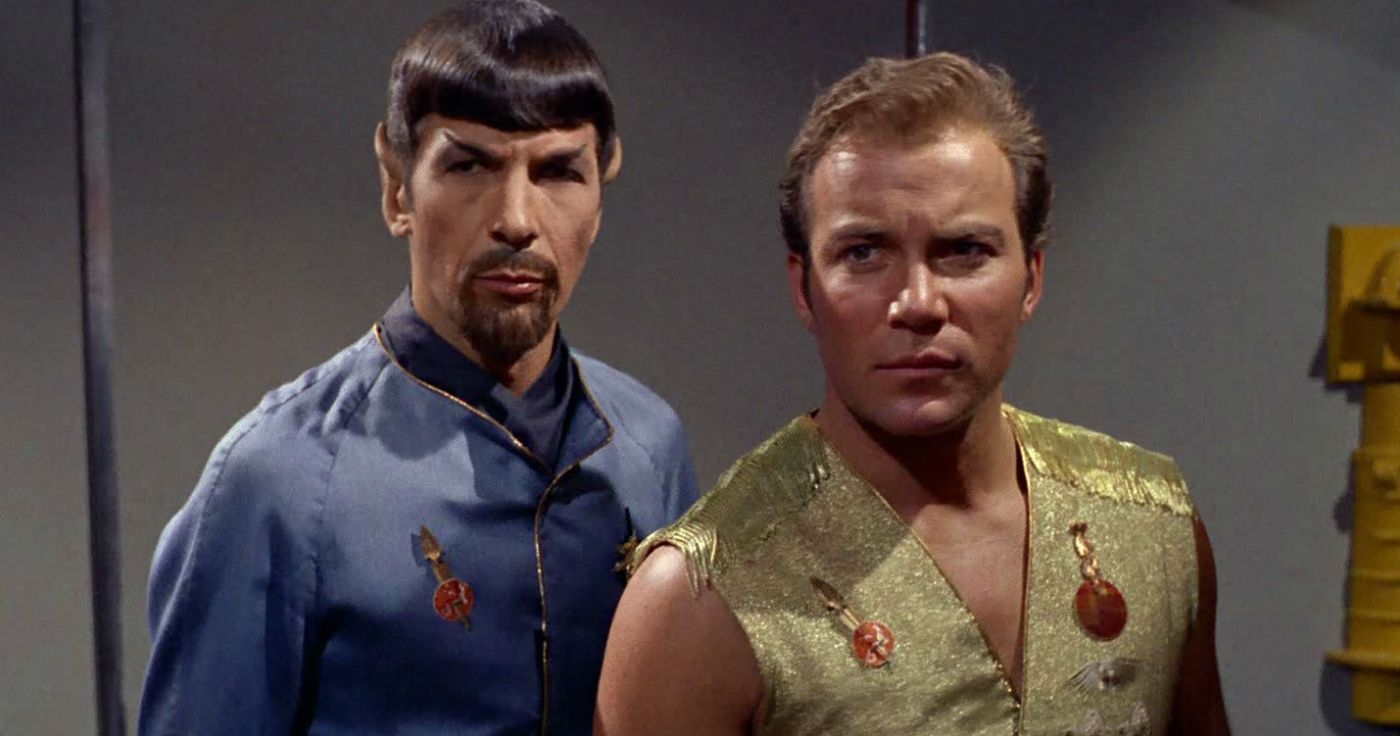Warning: SPOILERS below for Star Trek: Discovery!
-
While some fans complain that Star Trek: Discovery is a poor reflection of the Star Trek they know and love, as the new series progresses, it has taken on more and more pleasingly familiar elements of Star Trek. The fifth episode of Discovery, "Choose Your Pain," introduced one of the Original Series' fan favorite baddies, Harry Mudd (Rainn Wilson), who encounters Discovery's Captain Lorca (Jason Isaacs) when they are captured and imprisoned by the Klingons. By the end of "Choose Your Pain", Discovery dropped a major hint as to another classic aspect of Star Trek to which the crew of the Discovery are poised to boldly go.
Thus far, much of the drama on board the Discovery has centered around its Mycelium spore displacement drive. With the destruction of their sister ship the U.S.S. Glenn, Discovery is now the only starship in Starfleet with a Mycelium spore drive, which allows it to jump at any point across the known universe instantaneously. Getting the spore drive, the invention of Lt. Paul Stamets (Anthony Rapp), to actually function properly was a puzzle that Michael Burnham (Sonequa Martin-Green) solved when she discovered the Tardigrade monster found in the wreck of the Glenn that Captain Lorca had beamed aboard the Discovery is capable of symbiotic communication with the spores. When plugged into the navigational device salvaged from the Glenn, the Tardigrade is able to act as a super computer that can process coordinates for space jumps. With the help of the Tardigrade - who was named Ripper - Discovery was able to successfully make long range jumps and become the Federation's greatest weapon in the war against the Klingons.
However, being plugged into the Mycelial spore drive took a physical and emotional toll on the Tardigrade. As Discovery made copious use of the spore drive to battle the Klingons over a period of weeks, the Tardigrade grew considerably weaker. They were slowly killing the Tardigrade. The situation was exacerbated when Captain Lorca was captured by the Klingons and Discovery was charged with rescuing their Captain. To do that, acting Captain Saru (Doug Jones), disregarding Burnham's concern for the Tardigrade's safety when weighed against saving Captain Lorca, ordered the Tardigrade plugged back into the spore drive. Though Burnham, Stamets, and Cadet Sylvia Tilly (Mary Wiseman) determined that they could substitute a different biological life form for the Tardigrade if it was injected with the Tardigrade's DNA sequencing, there was no time for tests to determine which lifeforms would be most suitable. When the Tardigrade was plugged back into the spore drive, it collapsed and reverted into a hibernating state, with barely detectable life signs.
When faced with orders to revive the Tardigrade and get the spore drive back online so they could jump into Klingon space and save Lorca, Stamets secretly injected himself with the Tardigrade DNA and plugged himself into the spore drive. It worked; Stamets was able to calculate the jump and Discovery was able to save their captain and jump back out of Klingon space. Later, Dr. Hugh Culber (Wilson Cruz), one of Discovery's medical officers and Stamets' partner, cleared Stamets for duty, determining no ill effects from interfacing with the Mycelium network. However, when Stamets stepped away from their bathroom mirror, his reflection remained in the glass, moving independently! What does this mean?
While Star Trek history has no lack of Starfleet officers or other entities exhibiting unusual or even god-like powers, Stamets' mirror image seems rather a big clue as to another major piece of Star Trek lore already announced as part of Discovery: the Mirror Universe!
THE MIRROR UNIVERSE
In short, the Mirror Universe is an alternate reality where key characters and concepts in the Star Trek Universe are their exact opposite. (The Mirror Universe, however, is an entirely different alternate reality than the Kelvin timeline of the J.J. Abrams-produced Star Trek films). The Mirror Universe was first introduced in the second season episode of The Original Series titled "Mirror Mirror" when Captain Kirk (William Shatner) was beamed into this alternate reality where the Federation is an evil entity called the Terran Empire. The Mirror Universe's most famous symbol was an evil Spock (Leonard Nimoy) sporting a goatee.
Star Trek: Enterprise, the prequel series that takes place a century before both The Original Series and Discovery, also produced episodes set in the Mirror Universe. The evil mirror version of Captain Jonathan Archer revealed that the Terran Empire had existed for "centuries" and Star Trek history was changed in numerous ways, such as Zefram Cochrane, the inventor of warp drive, shooting the first Vulcan who set foot on Earth soil during First Contact, which set off interstellar war. By the time of Kirk's era, the Terran Empire was the dominant evil power in the Alpha Quadrant, having conquered other races like the Vulcans, Denobulans, Andorians, and Orions. The Mirror Universe continued in Star Trek: Deep Space Nine, which revealed that by the 24th century, the Klingon Cardassian Alliance had overwhelmed the Terran Empire. The Mirror Universe episodes always featured twisted versions of beloved Star Trek characters, and many of them died violent deaths in the endless power struggles that exemplified this alternate reality.
Stamets' reflection in the mirror, however, hints at a new way Discovery may be presenting the Mirror Universe. Typically, Star Trek characters from 'our' universe temporarily venture to the Mirror Universe and vice versa. Stamets's independent reflection in the mirror adds a horror movie element. Stamets interfacing with the Mycelium spore network may have allowed him access to the Mirror Universe while somehow creating a means for his Mirror double to see into 'our' universe. Whether or not an evil Stamets can enter 'our' universe or there will be some kind of switch of the two Stamets could open up some fascinating possibilities. The Mycelium spore drive opening up access to the Mirror Universe may also provide a clue as to why Starfleet has to eventually scrap the use of the Mycelium spore drive, which explains why the technology is not only out of use but never mentioned again in any other Star Trek series.
NEXT: STAR TREK: DISCOVERY RIPPER ORIGIN AND NAVIGATOR EXPLAINED
Star Trek: Discovery streams Sundays @ 8:30pm ET on CBS All-Access and internationally on Netflix.


